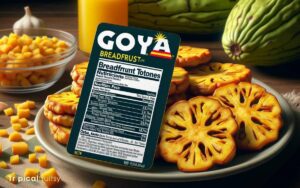Can You Eat Breadfruit Raw? Unveiling the Truth!
Yes, you can eat breadfruit raw if it is fully ripe. Ripe breadfruit has a creamy texture and sweet taste, making it suitable for raw consumption.
However, eating raw unripe breadfruit is not recommended due to the presence of indigestible compounds.
Breadfruit is a tropical fruit that can be eaten at different ripeness levels, each providing unique flavors and textures. While it is often cooked, fully ripe breadfruit can be enjoyed raw.
The ripeness of the fruit is key to determining if it can be eaten without cooking:
Eating unripe breadfruit raw may lead to digestive discomfort due to its complex carbohydrates.
Fully ripe breadfruit can be a delicious and nutritious addition to your diet when eaten raw.

Key Takeaway
Understanding Breadfruit Basics

Breadfruit, originating from the South Pacific and belonging to the mulberry family, is a starchy tropical fruit that is often compared to potatoes in texture and taste when cooked.
Scientifically classified as Artocarpus altilis, breadfruit is a prolific perennial that plays a crucial role in both ecological forestry and as a carbohydrate source in tropical regions. Its cultivation is rooted in agroforestry systems that promote biodiversity and soil health.
The fruit’s versatility is notable; it can be consumed at various stages of ripeness, offering different culinary possibilities.
In its raw state, the texture and flavor profiles are markedly different, which raises questions about its edibility and nutritional alterations in uncooked form. These inquiries naturally lead to an examination of the nutritional profile of breadfruit.
Nutritional Profile of Breadfruit

Commonly consumed in various stages of ripeness, breadfruit provides a substantial nutritional yield, featuring essential vitamins, minerals, and dietary fiber.
This tropical staple is particularly rich in complex carbohydrates, which are vital for sustained energy release.
Its caloric content is predominantly derived from these carbohydrates, positioning it as a potential staple food for energy-intensive diets.
Additionally, breadfruit contains moderate amounts of protein, which complements its carbohydrate profile for balanced nutrition.
In terms of micronutrients, breadfruit is a noteworthy source of vitamin C, potassium, and certain B vitamins, such as niacin.
Furthermore, the presence of antioxidants and phytonutrients in breadfruit contribute to its potential health benefits, which may include anti-inflammatory properties and bolstered immune defense.
The dietary fiber found in breadfruit plays a role in digestive health, aiding in regular bowel movements and potentially reducing the risk of chronic diseases.
Risks of Eating Breadfruit Raw

While breadfruit is nutritious when cooked, consuming it raw can pose several health risks due to potential irritants and indigestible components.
- Gastrointestinal Discomfort: Raw breadfruit contains complex carbohydrates that may be difficult to digest. The presence of certain compounds can cause bloating, gas, or stomach pain.
- Potential Toxins: Unripe breadfruit has higher levels of compounds that can be toxic or cause unpleasant reactions. These include protease inhibitors that interfere with protein digestion and certain alkaloids.
- Allergic Reactions: Some individuals may have an allergic response to raw breadfruit. Symptoms can range from mild to severe and include itching, swelling, and difficulty breathing.
Understanding these risks is crucial, which naturally leads to the importance of recognizing when breadfruit is ripe and safe to consume.
How to Identify Ripeness

Determining the exact stage of ripeness is essential for safely enjoying breadfruit in its raw form. To accurately assess ripeness, one must conduct a thorough analysis of the fruit’s external characteristics.
A ripe breadfruit exhibits a softening of the skin, which transitions from a bright green to a yellowish or brownish hue.
The presence of latex diminishes as the fruit matures, making the absence of a sticky sap upon incision a clear indicator of ripeness.
Furthermore, a gentle squeeze should yield a slight give, indicating the softening of the flesh inside. The olfactory sense is also instrumental, with a ripe breadfruit emitting a sweet, fragrant aroma.
These tactile and aromatic clues provide an empirical basis for identifying the optimal moment for consumption.
Preparing Breadfruit for Raw Consumption

Prior to consuming breadfruit in its raw state, proper preparation is pivotal to ensure both the safety and palatability of the fruit.
Selecting a ripe breadfruit is critical, as it dictates the texture and sweetness, and thus requires systematic assessment of its external coloration and tactile properties.
The subsequent steps involve thorough cleaning to remove any surface contaminants and the application of precise peeling techniques to retain maximum nutritional value while discarding the inedible skin.
Ripe Fruit Selection
Selecting a ripe breadfruit is essential for raw consumption as it ensures a sweet, soft texture that is both palatable and nutritious.
The process of identifying a ripe fruit is both an art and a science, involving a multi-sensory assessment:
Visual Cues:
- Bright, yellow-green skin
- Absence of greenish tinge, indicating maturity
- Visible browning of the skin’s small sections, a natural ripening sign
Tactile Examination:
- Yields slightly to gentle pressure, similar to a ripe avocado
- Skin should feel smooth, not rigid
Olfactory Indicators:
- Emits a fragrant, sweet smell
- Lack of an astringent or sour odor
An analytical approach to selecting a breadfruit for raw consumption maximizes the fruit’s inherent flavor profile and nutritional value, ensuring an optimal eating experience.
Cleaning and Peeling Methods
Once a ripe breadfruit has been chosen, it is crucial to properly clean and peel the fruit to ensure it is safe and enjoyable to consume raw.
The surface of the breadfruit should be washed under running water to remove any external contaminants. A produce brush can be utilized to scrub the skin gently, which can dislodge minute particles and potential residues.
After thorough cleansing, the breadfruit’s thick skin must be removed. This process requires a sharp knife to effectively separate the skin from the flesh without excessive waste.
A peeling method that preserves the maximum amount of edible fruit involves making shallow, longitudinal cuts and carefully peeling away strips of the outer layer, maintaining vigilance to excise any residual sap, which can be an irritant.
Is Freezing Raw Breadfruit a Way to Preserve It for Raw Consumption?
Freezing raw breadfruit stepbystep is an effective way to preserve it for raw consumption. Start by cleaning and peeling the fruit, then cut it into desired portions. Blanch the pieces in boiling water for a few minutes, then transfer them to an ice bath. Pat dry and place in airtight containers before freezing.
Alternative Ways to Enjoy Breadfruit

While consuming breadfruit raw is an option for some, culinary versatility is a hallmark of this tropical staple.
Transforming breadfruit into chips through a process of thin slicing and frying offers a crispy, nutritious alternative to conventional snack options.
On the other hand, roasting techniques, which involve exposure to high heat to enhance the fruit’s natural sweetness, present a robust method for integrating breadfruit into warm dishes.
Breadfruit Chips Recipe
Breadfruit chips offer a crispy and nutritious alternative to traditional potato snacks and can be easily prepared with a simple recipe.
Analysis of the breadfruit’s composition reveals its high fiber content and rich array of vitamins, making it a healthful addition to one’s diet. Preparing breadfruit chips involves a careful process to ensure optimal texture and taste.
Ingredients:
- Ripe breadfruit
- Olive or coconut oil
- Salt, to taste
Preparation:
- Thinly slice the breadfruit.
- Toss slices in minimal oil to lightly coat.
Cooking:
- Bake or air-fry until golden brown.
- Ensure even heat distribution for uniform crispness.
This methodical approach yields a snack that is both palatable and beneficial, aligning with dietary preferences for wholesome, plant-based options.
Roasted Breadfruit Techniques
Roasting transforms the starchy flesh of breadfruit into a soft, flavorful delicacy, offering a versatile culinary experience for those seeking alternative preparation methods.
The process of roasting catalyzes the Maillard reaction, which is responsible for the development of complex flavors and aromas.
To optimize this effect, the breadfruit is typically scored or cut into sections, allowing heat to permeate evenly and facilitate a uniform textural transformation.
Experts recommend preheating the oven or grill to a medium-high temperature before introducing the breadfruit.
The roasting duration is contingent upon the size of the breadfruit and the desired level of caramelization. Rotating the fruit periodically ensures an even roast.
Once the outer skin becomes charred and the interior reaches a custard-like consistency, the roasted breadfruit is ready to be savored.
Conclusion
Breadfruit serves as a versatile component in diverse culinary practices, offering significant nutritional benefits when appropriately consumed. While ripe breadfruit may be consumed raw, caution is advised due to potential risks.
Preparation and ripeness assessment are crucial to mitigate any adverse effects. As the adage goes, ‘An ounce of prevention is worth a pound of cure,’ emphasizing the importance of proper handling to fully reap breadfruit’s advantages without incurring health detriments.






